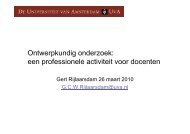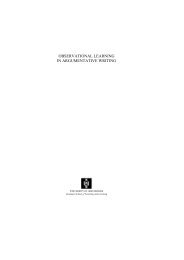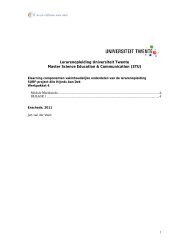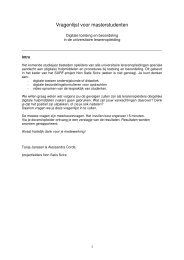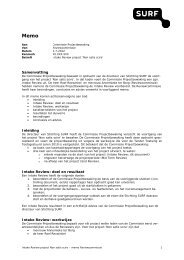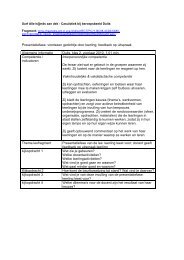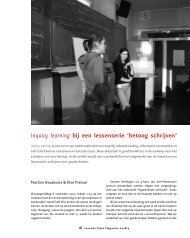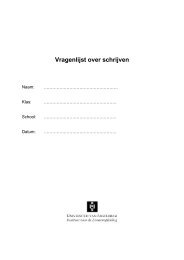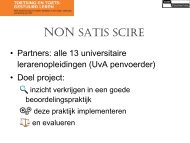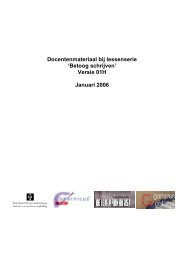to 10-year-old Turkish pupils in Flemish primary education
to 10-year-old Turkish pupils in Flemish primary education
to 10-year-old Turkish pupils in Flemish primary education
Create successful ePaper yourself
Turn your PDF publications into a flip-book with our unique Google optimized e-Paper software.
22 VERHEYDEN, VAN DEN BRANDEN, RIJLAARSDAM, VAN DEN BERGH and DE MAEYER<br />
subprocess <strong>in</strong> Hayes and Flower’s (1980) writ<strong>in</strong>g process model – may be helpful <strong>to</strong><br />
understand this challenge. The authors dist<strong>in</strong>guish four steps <strong>in</strong> the translat<strong>in</strong>g phase:<br />
1. Elaboration: digg<strong>in</strong>g up content and reshap<strong>in</strong>g it;<br />
2. L<strong>in</strong>earisation: transform<strong>in</strong>g the hierarchically arranged content <strong>in</strong><strong>to</strong> a l<strong>in</strong>ear preverbal<br />
semantic-syntactic structure (subject–predicate);<br />
3. Formulation: match<strong>in</strong>g the semantic-syntactic structure with grammatical and lexical<br />
structures;<br />
4. Execution: putt<strong>in</strong>g the sentence on paper.<br />
The transition from phase 2 <strong>to</strong> 3 is highly complicated for children with limited target<br />
language proficiency: they might lack the grammatical and lexical skills <strong>to</strong> turn a preverbal<br />
message <strong>in</strong><strong>to</strong> an adequate verbal construction. This tension is likely <strong>to</strong> come <strong>to</strong> the surface of<br />
these young children’s texts <strong>in</strong> different ways. For <strong>in</strong>stance, they may avoid treat<strong>in</strong>g certa<strong>in</strong><br />
aspects of the message because they cannot f<strong>in</strong>d the right words. Or, look<strong>in</strong>g for alternative<br />
ways <strong>to</strong> get parts of their message across, they may lose the general overview of what they<br />
have written so far, and as a result, produce <strong>in</strong>coherent text (Weigle, 2002). The attention<br />
they have <strong>to</strong> devote <strong>to</strong> try<strong>in</strong>g <strong>to</strong> express complex ideas may be at the cost of accuracy (or<br />
vice versa), <strong>in</strong> l<strong>in</strong>e with Skehan’s (2007) limited attention hypothesis. Further, the language<br />
they ultimately put on paper will reflect their current state of <strong>in</strong>terlanguage (Ellis, 1985),<br />
<strong>in</strong>clud<strong>in</strong>g sentences that do not yet meet the standards of native speakers. Recent studies of<br />
young second language learners confirmed that they produced texts of a significantly lower<br />
quality than mother <strong>to</strong>ngue speakers (Howard, Christian & Genesee, 2004).<br />
In addition, a great proportion of the non-Dutch-speak<strong>in</strong>g <strong>pupils</strong> <strong>in</strong> <strong>Flemish</strong> <strong>education</strong><br />
belong <strong>to</strong> socioeconomically disadvantaged families. Numerous studies illustrate the<br />
strong impact of family support of early literacy development on the development of<br />
read<strong>in</strong>g and writ<strong>in</strong>g skills (Ravid & Tolch<strong>in</strong>sky, 2002), irrespective of the language <strong>in</strong><br />
which this support is provided (Reese et al., 2000). Wells (1985) shows strong<br />
correlations between the social status of families and the available sociocultural capital,<br />
<strong>in</strong>clud<strong>in</strong>g the importance attached <strong>to</strong> literacy. In l<strong>in</strong>e with this research, <strong>in</strong>ternational<br />
research of writ<strong>in</strong>g skills shows that the writ<strong>in</strong>g skills of children of lowly educated<br />
parents significantly lag beh<strong>in</strong>d (Moats, Foorman & Taylor, 2006).<br />
F<strong>in</strong>ally, a high proportion of socioeconomically disadvantaged non-native speakers of<br />
Dutch are enrolled <strong>in</strong> schools <strong>in</strong> which Dutch-speak<strong>in</strong>g peers do not constitute the majority<br />
of the student population because of the uneven division of the EEP-target children across<br />
<strong>Flemish</strong> schools (Desmedt & Nicaise, 2006). Various studies (Braun, Forges & Wolma<strong>in</strong>ck,<br />
1997; Krom, Verhelst & Veldhuijzen, 2004) have corroborated the impact of school/class<br />
population on the quality of children’s written output, because of a concentration of low-<br />
SES <strong>pupils</strong> and/or second language learners. In Wallonia non-<strong>in</strong>digenous (low-SES) <strong>pupils</strong><br />
perform significantly better for most text features <strong>in</strong> classes with a majority of <strong>in</strong>digenous<br />
<strong>pupils</strong> than <strong>in</strong> classes with a majority of non-<strong>in</strong>digenous <strong>pupils</strong>. With these results <strong>in</strong> m<strong>in</strong>d,<br />
Braun et al. wonder whether ‘l’égalite des chances ne passeraient-elles pas par une égalité de<br />
l’heterogénéité des classes sur l’ensemble du terri<strong>to</strong>ire?’ [equal opportunities, don’t they go<br />
via an equality of (heterogeneous) class composition over the terri<strong>to</strong>ry?] (p. 113).<br />
In <strong>Flemish</strong> <strong>education</strong> <strong>to</strong>day, many <strong>pupils</strong> of <strong>Turkish</strong>, Moroccan and other ethnic orig<strong>in</strong>s<br />
face the above-mentioned challenges. At present, it rema<strong>in</strong>s unclear whether these target<br />
<strong>pupils</strong> should be treated as a homogeneous group when it comes <strong>to</strong> their literacy<br />
development. Verhoeven (1997) and Smits and Aarnoutse (1997) have shown significant<br />
r United K<strong>in</strong>gdom Literacy Association 20<strong>10</strong>




